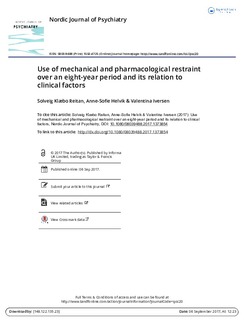| dc.contributor.author | Reitan, Solveig Merete Klæbo | |
| dc.contributor.author | Helvik, Anne-Sofie | |
| dc.contributor.author | Iversen, Valentina Cabral | |
| dc.date.accessioned | 2018-01-30T09:59:49Z | |
| dc.date.available | 2018-01-30T09:59:49Z | |
| dc.date.created | 2017-09-07T19:24:55Z | |
| dc.date.issued | 2017 | |
| dc.identifier.citation | Nordic Journal of Psychiatry. 2017, 24-30. | nb_NO |
| dc.identifier.issn | 0803-9488 | |
| dc.identifier.uri | http://hdl.handle.net/11250/2480589 | |
| dc.description.abstract | Background: Use of restraint and finding the balance between security and ethics is a continuous dilemma in clinical psychiatry. In daily clinic and in planning health-care service, knowledge on the characteristics of restraint situations is necessary to optimize its use and avoid abuse.
Methods: We describe characteristics in the use of pharmacological and mechanical restraint in psychiatric acute wards in a hospital in Middle Norway over an eight-year period. Data on all cases of mechanical and pharmacological restraint from 2004 to 2011 were retrospectively collected from hand-written protocols. Complementary information on the patients was obtained from the hospital patient administrative system.
Results: Restraint in acute wards was used on 13 persons per 100,000 inhabitants annually. The percentage of admitted patients exposed to restraint was 1.7%, with a mean of 4.5 cases per exposed patient. Frequency per 100 admitted patients varied from 3.7 (in 2007) to 10 (in 2009). The majority of restraint cases concerned male patients under 50 years and with substance-abuse, psychotic, or affective disorders. Significantly more coercive means were used during daytime compared to night and morning. There was a significant increase in pharmacological coercion during spring and mechanical coercion during summer.
Conclusions: Restraint was used on 1.7% of admitted patients, representing 13 per 100,000 inhabitants per year. Use of restraint was higher during certain periods of the day and was associated with the patient’s diagnosis, age, gender, and legal status of hospitalization. There was a marked variation over the years. | nb_NO |
| dc.language.iso | eng | nb_NO |
| dc.publisher | Taylor & Francis | nb_NO |
| dc.rights | Attribution-NonCommercial-NoDerivatives 4.0 Internasjonal | * |
| dc.rights.uri | http://creativecommons.org/licenses/by-nc-nd/4.0/deed.no | * |
| dc.title | Use of mechanical and pharmacological restraint over an eight-year period and its relation to clinical factors | nb_NO |
| dc.type | Journal article | nb_NO |
| dc.type | Peer reviewed | nb_NO |
| dc.description.version | publishedVersion | nb_NO |
| dc.source.pagenumber | 24-30 | nb_NO |
| dc.source.journal | Nordic Journal of Psychiatry | nb_NO |
| dc.identifier.doi | 10.1080/08039488.2017.1373854 | |
| dc.identifier.cristin | 1491921 | |
| dc.description.localcode | © 2017 The Author(s). Published by Informa UK Limited, trading as Taylor & Francis Group This is an Open Access article distributed under the terms of the Creative Commons Attribution-NonCommercial-NoDerivatives License (http://creativecommons.org/licenses/by-nc-nd/4.0/) | nb_NO |
| cristin.unitcode | 194,65,35,0 | |
| cristin.unitcode | 194,65,20,0 | |
| cristin.unitname | Institutt for psykisk helse | |
| cristin.unitname | Institutt for samfunnsmedisin og sykepleie | |
| cristin.ispublished | true | |
| cristin.fulltext | postprint | |
| cristin.qualitycode | 1 | |

